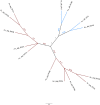Local-scale virome depiction in Medellín, Colombia, supports significant differences between Aedes aegypti and Aedes albopictus
- PMID: 35895627
- PMCID: PMC9328524
- DOI: 10.1371/journal.pone.0263143
Local-scale virome depiction in Medellín, Colombia, supports significant differences between Aedes aegypti and Aedes albopictus
Abstract
Aedes spp. comprise the primary group of mosquitoes that transmit arboviruses such as dengue, Zika, and chikungunya viruses to humans, and thus these insects pose a significant burden on public health worldwide. Advancements in next-generation sequencing and metagenomics have expanded our knowledge on the richness of RNA viruses harbored by arthropods such as Ae. aegypti and Ae. albopictus. Increasing evidence suggests that vector competence can be modified by the microbiome (comprising both bacteriome and virome) of mosquitoes present in endemic zones. Using an RNA-seq-based metataxonomic approach, this study determined the virome structure, Wolbachia presence and mitochondrial diversity of field-caught Ae. aegypti and Ae. albopictus mosquitoes in Medellín, Colombia, a municipality with a high incidence of mosquito-transmitted arboviruses. The two species are sympatric, but their core viromes differed considerably in richness, diversity, and abundance; although the community of viral species identified was large and complex, the viromes were dominated by few virus species. BLAST searches of assembled contigs suggested that at least 17 virus species (16 of which are insect-specific viruses [ISVs]) infect the Ae. aegypti population. Dengue virus 3 was detected in one sample and it was the only pathogenic virus detected. In Ae. albopictus, up to 11 ISVs and one plant virus were detected. Therefore, the virome composition appears to be species-specific. The bacterial endosymbiont Wolbachia was identified in all Ae. albopictus samples and in some Ae. aegypti samples collected after 2017. The presence of Wolbachia sp. in Ae. aegypti was not related to significant changes in the richness, diversity, or abundance of this mosquito's virome, although it was related to an increase in the abundance of Aedes aegypti To virus 2 (Metaviridae). The mitochondrial diversity of these mosquitoes suggested that the Ae. aegypti population underwent a change that started in the second half of 2017, which coincides with the release of Wolbachia-infected mosquitoes in Medellín, indicating that the population of wMel-infected mosquitoes released has introduced new alleles into the wild Ae. aegypti population of Medellín. However, additional studies are required on the dispersal speed and intergenerational stability of wMel in Medellín and nearby areas as well as on the introgression of genetic variants in the native mosquito population.
Conflict of interest statement
The authors have declared that no competing interests exist.
Figures







Similar articles
-
Aedes Anphevirus: an Insect-Specific Virus Distributed Worldwide in Aedes aegypti Mosquitoes That Has Complex Interplays with Wolbachia and Dengue Virus Infection in Cells.J Virol. 2018 Aug 16;92(17):e00224-18. doi: 10.1128/JVI.00224-18. Print 2018 Sep 1. J Virol. 2018. PMID: 29950416 Free PMC article.
-
Influence of dengue virus serotypes on the abundance of Aedes aegypti insect-specific viruses (ISVs).J Virol. 2024 Jan 23;98(1):e0150723. doi: 10.1128/jvi.01507-23. Epub 2023 Dec 14. J Virol. 2024. PMID: 38095414 Free PMC article.
-
Stable distinct core eukaryotic viromes in different mosquito species from Guadeloupe, using single mosquito viral metagenomics.Microbiome. 2019 Aug 28;7(1):121. doi: 10.1186/s40168-019-0734-2. Microbiome. 2019. PMID: 31462331 Free PMC article.
-
Aedes aegypti and Ae. albopictus microbiome/virome: new strategies for controlling arboviral transmission?Parasit Vectors. 2022 Aug 9;15(1):287. doi: 10.1186/s13071-022-05401-9. Parasit Vectors. 2022. PMID: 35945559 Free PMC article. Review.
-
The virome of vector mosquitoes.Curr Opin Virol. 2021 Aug;49:7-12. doi: 10.1016/j.coviro.2021.04.002. Epub 2021 May 12. Curr Opin Virol. 2021. PMID: 33991759 Review.
Cited by
-
Highly divergent and diverse viral community infecting sylvatic mosquitoes from Northeast Brazil.J Virol. 2024 Aug 20;98(8):e0008324. doi: 10.1128/jvi.00083-24. Epub 2024 Jul 12. J Virol. 2024. PMID: 38995042 Free PMC article.
-
The interplay between vector microbial community and pathogen transmission on the invasive Asian tiger mosquito, Aedes albopictus: current knowledge and future directions.Front Microbiol. 2023 Jul 27;14:1208633. doi: 10.3389/fmicb.2023.1208633. eCollection 2023. Front Microbiol. 2023. PMID: 37577425 Free PMC article. Review.
-
Leveraging insect-specific viruses to elucidate mosquito population structure and dynamics.PLoS Pathog. 2023 Aug 31;19(8):e1011588. doi: 10.1371/journal.ppat.1011588. eCollection 2023 Aug. PLoS Pathog. 2023. PMID: 37651317 Free PMC article. Review.
-
The application of metagenomics in the detection of arboviruses in mosquitoes (Diptera: Culicidade): a systematic review.Rev Inst Med Trop Sao Paulo. 2025 Jul 7;67:e46. doi: 10.1590/S1678-9946202567046. eCollection 2025. Rev Inst Med Trop Sao Paulo. 2025. PMID: 40638514 Free PMC article.
-
Characterizing viral species in mosquitoes (Culicidae) in the Colombian Orinoco: insights from a preliminary metagenomic study.Sci Rep. 2023 Dec 12;13(1):22081. doi: 10.1038/s41598-023-49232-9. Sci Rep. 2023. PMID: 38086841 Free PMC article.
References
-
- World Health Organization. A Global Brief on Vector-Borne Diseases; WHO, 2014.
MeSH terms
LinkOut - more resources
Full Text Sources
Research Materials
Miscellaneous

